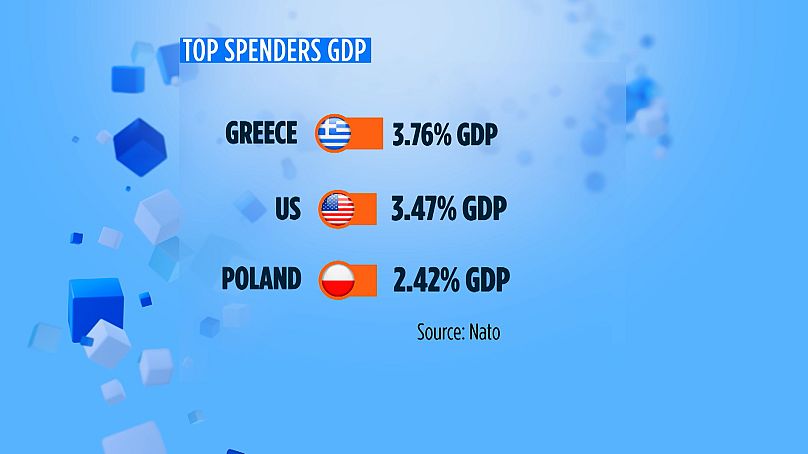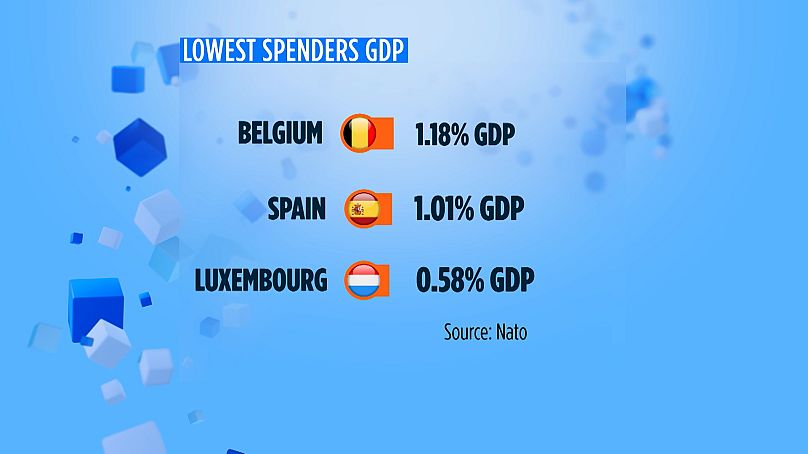Only seven of NATO's 30 allied countries met the military spending target of 2% of GDP set by the North Atlantic Alliance in 2022.
Only seven of NATO's 30 allied countries met the military spending target set by the North Atlantic Alliance in 2022, the military organisation's secretary general, Jens Stoltenberg, confirmed.
The goal is for each country to contribute 2% of its GDP to defence spending. At the moment, only Greece, the United States, Lithuania, Poland, the United Kingdom, Estonia and Latvia are meeting this commitment, which was set in 2014 as a target for 2024. The number of countries meeting the target is very low, but the pressure is increasing due to the geopolitical context.
New military spending targets
At the Alliance's upcoming summit in Vilnius in July, leaders will announce new defence investment commitments. NATO wants to see the 2% target as a basis "as a floor, not a ceiling" of what allies commit to invest in national defence.
Top and bottom spenders
Greece, the United States and Poland, followed by the Baltic states, are the countries that spend the highest percentage of their GDP on defence. And they exceeding the 2%.
Greece, because of its own troubled relationship with Turkey, tops the ranking with almost 4% of GDP. The Baltic countries are highly sensitive to hostility towards Russia and Poland and, for the same reasons, has found it very easy to increase budgets. Poland is making an effort of about 2.5% of GDP.
On the other side of the coin are Belgium, Spain and Luxembourg. The UK barely exceeds the target and France is slightly below. Italy and Germany also fall short of the 2% target.
A controversial yardstick
For experts, this is a controversial yardstick because it evaluates the economic effort made by each country, but does not reflect their real military capabilities, such as whether they have ships or strategic production capacity.
Félix Arteaga, senior researcher at the Real Instituto Elcano in Madrid, believes the 2% figure is controversial. He feels that although it serves to evaluate the economic contribution of each country and the effort each country makes in terms of its GDP, it is not a figure that can be used to evaluate the economic contribution of each country and the effort each country makes in terms of its GDP.
"It is not a figure that serves to measure what is contributed militarily through this expenditure," he says. "And in this sense, we see there are countries that have a very high military effort, more than 2%, and yet their real contribution to NATO's military capabilities is very small."
What does 2% of GDP mean?
Let's consider what 2% of GDP means to a country's economy. Take, for example, one of the countries that spends the least on defence - Spain. This country spends around 4% of its GDP on education and 8% on health.
In 2022, it spent 1% of its GDP on defence. Reaching NATO's target would mean doubling it, which would be half of what it spends on education.
"This commitment is very difficult to fulfil because the tendency is for defence budgets to be calculated downwards, while the rest of the social budget items continue to increase," says Arteaga.
The war in Ukraine on NATO's doorstep
As long as there is no war or a war economy that makes it necessary to prioritise defence spending, it will be very difficult to fulfil the financial requirements. Nor are experts confident that such an increase would be advisable in a short period of time.
The productive capacity of the European Union and the West, in general, cannot keep up with the demand generated by the war in Ukraine which means there is a spiral of inflation, and delays in cost deliveries and this affects the productive capacity of the defence sector.
"It is very difficult to spend this money well because you need to consider the management structures, and the personnel, to get a return on these investments. Moreover, in a situation of inflation like the one we have, much of the additional budget effort is offset by runaway inflation in terms of raw materials," Arteaga concludes.














